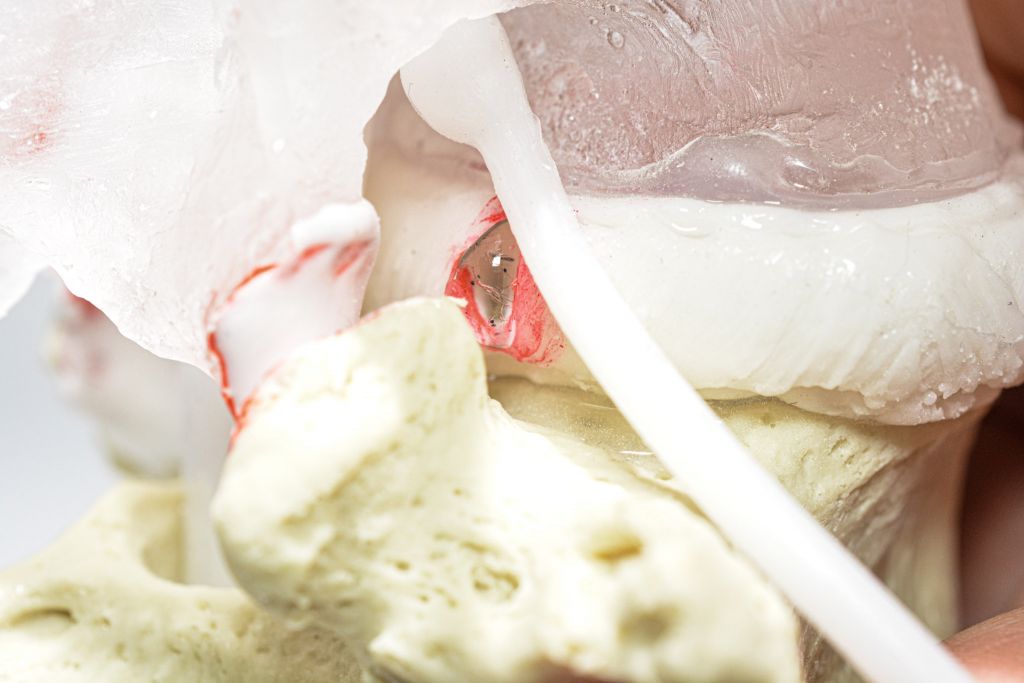
Disc herniation is one of the prevalent conditions that affects millions of people worldwide. A disc herniation model can be helpful to explain the severe pain that it can cause. Patients may also find it extremely difficult to comprehend the origins of their condition and how to treat it. Dynamic Disc Designs has developed state-of-the-art spine models, engaging chiropractors and physiotherapists. The models aid healthcare professionals in creating powerful educational demonstrations for their patients to comprehend the complexity of their condition. By using these models, practitioners can better explain low back and leg pain to patients, improving their management and recovery.
Disc herniation occurs when a spinal disc’s soft, jelly-like center is pushed through a tear in the outer region of the disc called the annulus. This can irritate any surrounding nerves, resulting in discomfort, numbness, or even weakness in the legs and back. Disc herniation can be brought on by injury, aging, or repeated strain. The primary site most commonly affected is the lumbar spine, which carries the body’s weight and allows movement.
Dynamic Disc Designs developed a line of detailed dynamic models that illustrate the dynamics of the human spine. This is not a static replica but illustrates how the spinal disc behaves in various positions and motions. By displaying load compression, shear and six degrees of movement, these models help patients perceive and comprehend the motions, postures and loads contributing to the symptoms. Such a dynamic illustration would demonstrate how, with enough pressure, the disc might bulge or rupture, thus explaining the pain and other symptoms that they go through.
The Dynamic Disc Designs models’ greatest advantage is their capacity to assist with patient education, which might result in more successful instances. There might be a lot of anxiety when thinking about medical concerns; visuals make it easier to take in. Observing a model with a disc herniation can help the patient understand the condition’s cause, leading to better healing postures and mobility adherence.
Chiropractors and physiotherapists often describe complicated anatomical and physiological aspects of a condition to their patients. Models from Dynamic Disc Designs help bridge the gap by clearly articulating disc herniation realistically and simply. They provide a visual aid that boosts the practitioner’s ability to describe the complex condition in a way that the patient will understand better and relate to it more.
In patients with disc herniation, pain is usually dull in the lower back and radiates down the leg, often accompanied by numbness in the lower extremities. A herniated intervertebral disc frequently results in nerve compression, causing pain radiation down the legs. Visualizing the origin of the symptoms lets the patients comprehend their condition and the importance of following their treatment plan.
Appropriate posture and movement are essential in managing disc herniation. Dynamic Disc Design models demonstrate the effect of posture during movement on the spine and discs. This will give the patient insight into how pick-up techniques can strengthen their approach to exercises and ergonomic practice.
Knowledge is power, and so is dealing with a chronic pain condition like disc herniation. Patients who understand their condition will most likely follow their plans and treatment measures and take proactive steps to avoid further injury. Given that they equip patients with the information they need to manage their conditions properly, these models have the potential to serve as instructional aids.

Chiropractic practitioners can significantly benefit from training in using the different models of Dynamic Disc Designs. Through organized training sessions and workshops, practitioners could become acquainted with the methods of demonstration and explanation of disc herniation using the models. In particular, flexion load will drive the nucleus posteriorly, and extension distraction will retract it. This often incorporates hands-on experience using the model, giving practitioners several scenarios and patient experiences. Practitioners can role-play with the models to better educate their patients and anticipate each patient’s questions.
Integrating dynamic models in patient consultations could make the patient education experience different. This would enable the practitioner to use the models to explain the diagnosis and treatment plan to the patient. Not only does this help in clarification, but it also engages patients to participate actively in their care.
In this way, the patient gradually realizes the importance of exercise adherence and the required correction in body posture from the beginning through the physical presentation of their condition. Greater compliance with the protocols and treatment contributes to a better treatment outcome.
A practical disc herniation model for teaching disc herniation self-management has been developed by Dynamic Disc Designs. When patients are involved in the process. Dynamic Disc Designs models can thus be tweaked according to feedback to retain accuracy and easy user adaptability. When products are realigned with the demands of the healthcare community, an efficient upgrade can be accomplished, and the provider will be positively appreciated. As a result, these models are more specifically designed to meet the needs of practical patient education and treatment, increasing their value to patient outcomes and satisfaction.
Dynamic Disc Designs have revolutionized patient education in chiropractic and physiotherapy clinics with innovative disc herniation models. According to the feedback from customers, the disc herniation model provides patients with disc herniation with understandable visual explanations enhanced by more patient commitment. The models help the patient understand their condition and, arguably, empower them with the knowledge to manage symptoms effectively. The main goal of this is to help chiropractors and physiotherapists, who can improve patient education and communication by using these dynamic models in their practice and ultimately foster the best outcomes of disc herniation management.
Share Now